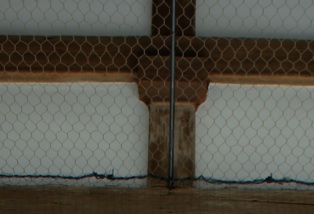Nakazonae on:
[Wikipedia]
[Google]
[Amazon]
 is a Japanese classification of several intercolumnar struts of different origin installed in the intervals between bracket complexes ('' tokyō'') at wooden architectures in East Asia.
In origin they were necessary to help support the roof; however, at the end of the 10th century the invention of the
is a Japanese classification of several intercolumnar struts of different origin installed in the intervals between bracket complexes ('' tokyō'') at wooden architectures in East Asia.
In origin they were necessary to help support the roof; however, at the end of the 10th century the invention of the
Image:Minozuka2.jpg, Minozuka (''Rōmon'', Hongaku-ji, Kamakura, Kanagawa, Kamakura)
Image:Horyu-ji28s3200.jpg, ''Warizuka'' (sides) and ''tokyō'' (center) (Hōryū-ji)
Image:Toshogu-Sleeping-Cat-Dsc3972.jpg, ''Sukashi-kaerumata'' (Kitano Tenman-gū)
Image:Ita-Kaerumata Hongaku-ji Mon.jpg, ''Ita-kaerumata'', Yonkyaku-Mon (architecture), mon, Hongaku-ji, Kamakura, Kanagawa, Kamakura
Image:Hana-hijiki.jpeg, ''Hana-hijiki'', center, between two ''tokyō'' (Hōryū-ji, Nandaimon)
 is a Japanese classification of several intercolumnar struts of different origin installed in the intervals between bracket complexes ('' tokyō'') at wooden architectures in East Asia.
In origin they were necessary to help support the roof; however, at the end of the 10th century the invention of the
is a Japanese classification of several intercolumnar struts of different origin installed in the intervals between bracket complexes ('' tokyō'') at wooden architectures in East Asia.
In origin they were necessary to help support the roof; however, at the end of the 10th century the invention of the hidden roof
The Also sometimes called . ''Koya'' is the technical term for the space between the roof and the ceiling. is a type of roof widely used in Japan both at Buddhist temples and Shinto shrines. It is composed of a true roof above and a second roof be ...
The hidden roof () is a structure, composed of a true roof with a second roof beneath, which permits to obtain a heavily slanted roof with arbitrarily shallow eaves
The eaves are the edges of the roof which overhang the face of a wall and, normally, project beyond the side of a building. The eaves form an overhang to throw water clear of the walls and may be highly decorated as part of an architectural styl ...
. Having its own, hidden roof support system, it made the ''nakazonae'' largely redundant. made them superfluous. They remained in use, albeit in a purely decorative role, and are typical of the Wayō
is a Buddhist architectural style developed in Japan before the Kamakura period (1185-1333), and is one of the important Buddhist architectural styles in Japan along with ''Daibutsuyō'' and the ''Zenshūyō'', which were developed based on ...
style. The ''Zenshūyō'' style used by Zen temples has instead bracket complexes even between posts.
Shuzhu or Kentozuka
The simplest of these struts are the composed of a short post and a bearing block.Minozuka
Similar to the ''kentozuka'' is the fan-shaped strut called (see gallery), which can have decorations on the two sides called or a collar-like decoration between post and bearing block. The name comes from its shape, similar to that of a traditional straw raincoat called ''mino''.Hana-hijiki
A variant of the ''hijiki'' (肘木) or ''timu'' (替木) is the , composed by either one or two horizontal series bearing blocks standing over an elaborately carved floral pattern.Renzigong or Warizuka
The 人-shaped dougong (Chinese: 人字栱) strut consists of a wooden inverted V topped by a bearing block.Kaerumata or Tuofeng
The or tuofeng (駝峰) was named after its shape, resembling a frog's splayed legs. Its origins are not known with certainty, but it may be an evolution of the ''warizuka''. Invented during the 12th century, it became gradually more and more elaborate, to the point where in theEdo period
The or is the period between 1603 and 1867 in the history of Japan, when Japan was under the rule of the Tokugawa shogunate and the country's 300 regional '' daimyo''. Emerging from the chaos of the Sengoku period, the Edo period was characteriz ...
the strut itself would be hidden behind the decorations.
Two basic types exist. In the case of the , the space above and between the frog legs is either empty or carved. In the case of the , the space between the legs has completely disappeared, leaving behind a solid board with an external frog-leg profile.
Types of ''nakazonae''
Notes
References